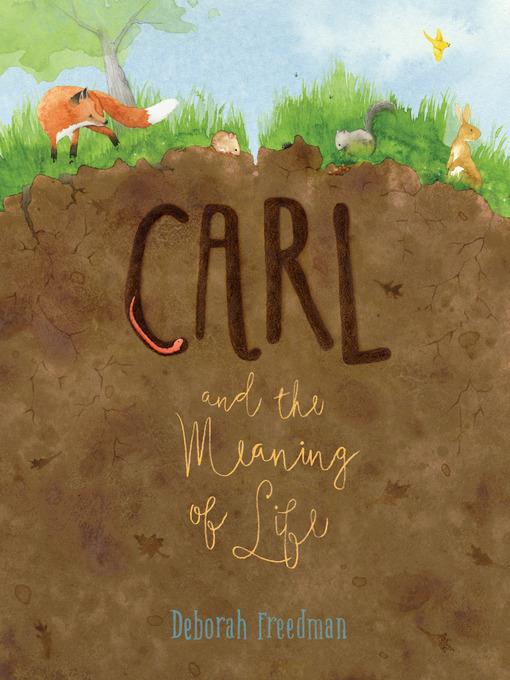
Carl and the Meaning of Life
فرمت کتاب
ebook
تاریخ انتشار
2019
Lexile Score
510
Reading Level
0-1
ATOS
2.4
Interest Level
K-3(LG)
نویسنده
Deborah Freedmanشابک
9780698192584
کتاب های مرتبط
- اطلاعات
- نقد و بررسی
- دیدگاه کاربران
نقد و بررسی

February 11, 2019
Freedman introduces Carl by telling readers what he is not: “Carl was not a bird“ (nor a bear, nor a beaver). Carl is an earthworm, and he lives underneath the other forest animals. A cross-section of soil shows Carl next to a curling line of type describing his daily activities: “burrowing, tunneling, digesting dead leaves... turning hard dirt into fluffy soil.” When a field mouse asks him why he does what he does, Carl’s search for answers keeps him away from his work, and the earth dries up around him. “I can’t find any grubs!” cries a ground beetle. With that, Carl understands his purpose. Freedman’s spreads shows how tiny organisms help to keep the natural world in balance in this inventive worm’s-eye view of the web of life. Ages 3–5.

Starred review from March 1, 2019
PreS-Gr 2-Carl is an earthworm who spends his day tunneling through the soil. When a field mouse asks him why he does what he does, Carl realizes that he does not know-but he is determined to find out. Carl visits with Bear, Rabbit, Fox, and others who are aware of their own purposes, but not Carl's. It takes a tiny ground beetle to enlighten him. Nature-inspired watercolor illustrations are gentle and inviting. The text appears in a simple black font, complementing the artwork. When Carl is busy at his job, the text is white against the brown earth and meanders across the pages, following Carl's tunneling track. Tiny black eyes and communicative postures express the attitudes of Carl and the other animals. But on the last page, when Carl finally learns his raison d'etre, readers also see a hint of his satisfied smile. VERDICT This book is a poignant example of the important contributions of even the smallest creature, but it's better than that-it's a science lesson as well. Freedman subtly explains the delicate balance of nature and each creature's role in maintaining it. Carl is an endearing protagonist.-Lisa Taylor, Florida State College, Jacksonville
Copyright 2019 School Library Journal, LLC Used with permission.

February 15, 2019
Earthworm Carl works busily underground, burrowing, eating, and depositing soil-enriching castings--until a field mouse asks, "Why?"Carl suspends his usual activities to find out, querying a rabbit, fox, squirrel, and many others until, over time, these very creatures are compelled to travel away for sustenance. When a ground beetle despairs, "I can't find any grubs!" Carl realizes that the soil he has neglected has become hard-packed dirt. Suddenly, his purpose is clear. "For hours into days, weeks into months, Carl munched, digested, left castings, and tunneled...and turned that hard dirt back into rich soil." The returning animals appreciate the results: sprouting seeds, blossoming clover, and an integrated ecosystem made possible by earthworms like Carl. Freedman's digitally assembled watercolors feature washes of green, yellow, ocher, and brown. She augments her speaking cast of woodland animals with additional small creatures for children to discover. A brief but pithy author's note celebrates the interconnectedness of all creatures, including the reader. A quote from Darwin on the importance of the earthworm completes the package.A pleasant, simplified examination of the significance of the lowly earthworm, just in time for garden encounters. (Picture book. 3-7)
COPYRIGHT(2019) Kirkus Reviews, ALL RIGHTS RESERVED.

Starred review from March 15, 2019
Preschool-G *Starred Review* Carl the earthworm spends his days burrowing underground, eating hard dirt, and turning it into fluffy soil. But when a field mouse asks him why he does this, Carl is stumped and sets off to find out. The tiny pink annelid crawls through the grass and makes inquiries among a variety of animals. A rabbit reveals she lives for her babies, but child-free Carl knows that can't be his raison d'�tre. Next, he approaches a fox, whose purpose is to hunt, and then a squirrel, whose nutty habits cause trees to grow. Yet no one knows the meaning behind Carl's subterranean activities. As he continues his journey, the neglected ground around his home turns hard and uninhabitable. Returning to this barren landscape, Carl finally understands how he fits into the bigger picture, and he happily gets to work converting the dirt into rich soil. Freedman demonstrates how one tiny creature can make a big difference and is an important part of an ecosystem. Her simple storytelling is supported by fabulous illustrations, created with watercolor and pencil, that cut away to show Carl underground?the text following his undulating path. Vibrant greens and softly rendered animals populate the surface terrain, upon which Carl appears as an adorable squiggle. This spare but endearing story will help youngsters understand the wonder and interconnectedness of nature.(Reprinted with permission of Booklist, copyright 2019, American Library Association.)

























دیدگاه کاربران